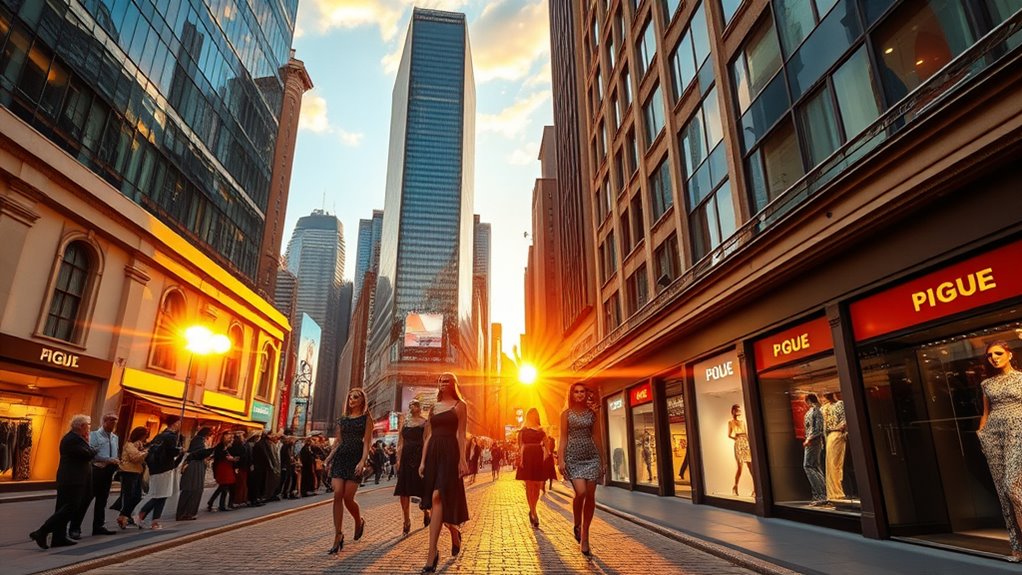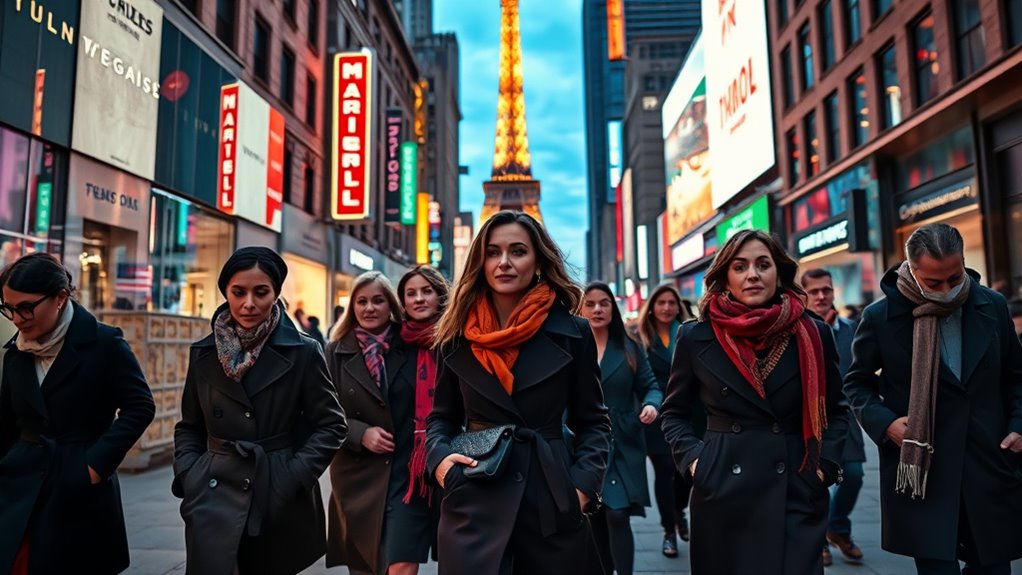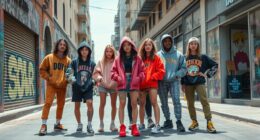Fashion capitals like Paris, Milan, New York, and London have long defined global style by blending tradition, innovation, and cultural influence. Today, emerging designers and sustainable practices are reshaping what makes a city influential, emphasizing responsibility, diversity, and creativity. These cities evolve through new talent and eco-conscious approaches, pushing fashion forward. Keep exploring to discover how these shifts are transforming the world’s most iconic fashion hubs and what future trends may emerge.
Key Takeaways
- Traditional fashion capitals like Paris, Milan, New York, and London shape global trends through history, culture, and iconic fashion events.
- Emerging designers and sustainable practices are redefining what makes a city influential in the fashion industry.
- Cities fostering innovative, eco-conscious, and culturally diverse fashion scenes become new hubs of global style.
- Fashion weeks, social media, and local crafts showcase a city’s unique influence and emerging talent.
- The future of fashion capitals depends on responsible innovation, inclusivity, and the ability to adapt to evolving industry trends.

Have you ever wondered where the world’s most influential fashion trends originate? It’s not just about glamorous runways or famous brands; it’s about the cultural heartbeat of a city and the people who bring it to life. Fashion capitals like Paris, Milan, New York, and London have long been recognized for shaping global style, but their influence isn’t solely rooted in tradition. Today, emerging designers are redefining what makes a city a fashion hub, especially when it comes to sustainable fashion. These young creatives are pushing boundaries, blending innovative designs with eco-conscious practices, and turning their cities into hotspots for responsible fashion. When you look at a city’s fashion scene, you’re witnessing a dynamic mix of history, innovation, and social awareness. Emerging designers often lead the charge, introducing fresh ideas that challenge the status quo and inspire the industry to shift toward sustainability. They’re not just designing for aesthetics—they’re advocating for change, using eco-friendly materials, ethical production methods, and transparent supply chains to make a difference. This focus on sustainable fashion is transforming traditional fashion capitals into leaders of responsible innovation. It’s exciting to see how these designers are gaining recognition, turning small studios into influential labels, and attracting global attention. Their work often reflects the city’s unique culture but also carries a universal message of environmental responsibility. As a fashion enthusiast, you get a front-row seat to this evolution—watching how these emerging talents influence trends, redefine luxury, and challenge fast fashion. Their ability to combine style with sustainability is what sets them apart and helps solidify their city’s status as a true fashion capital in the modern era. *Furthermore*, these designers often draw inspiration from local traditions and crafts, adding authenticity and diversity to the global fashion narrative. You can follow their journeys through fashion weeks, social media, and boutique openings, witnessing firsthand how they shape the future of style. It’s no longer enough for a city to have a rich fashion history; it now needs to be a breeding ground for innovation, inclusivity, and environmental consciousness. When you understand the importance of emerging designers and sustainable fashion, you realize that fashion capitals are evolving into ecosystems where new ideas flourish, reflecting a more conscious and diverse world. Additionally, the incorporation of eco-conscious practices into their collections is helping to redefine what it means to be a true fashion capital in the 21st century. So, the next time you think about global style, remember that these cities are not just about glamour—they’re about progress, responsibility, and the power of fresh talent to change the industry from the ground up.
Frequently Asked Questions
How Do Emerging Cities Gain Recognition as Fashion Capitals?
To gain recognition as a fashion capital, you need to host impactful fashion weeks that attract global attention. You should foster strong designer collaborations and showcase innovative, diverse styles. Building a vibrant local fashion scene and gaining support from industry insiders also help elevate your city’s status. Consistent media coverage and international partnerships further boost your reputation, positioning you as a must-visit destination for fashion insiders and trendsetters alike.
What Role Does Cultural Diversity Play in Defining a Fashion City?
Cultural diversity plays a crucial role in defining a fashion city by fostering cultural fusion, where different traditions blend to inspire innovative designs. You’ll notice traditional influences from various communities shape local styles, making the city’s fashion unique. This mix of cultures sparks creativity, attracts international designers, and sets trends that resonate globally. Embracing cultural diversity guarantees the city remains vibrant, authentic, and influential in the global fashion scene.
How Do Economic Factors Influence a City’s Fashion Industry?
You see, economic factors like thriving luxury markets and robust retail infrastructure directly shape a city’s fashion scene. When wealth flows into a city, it attracts high-end brands and innovative designers, elevating its style reputation. Conversely, limited retail infrastructure can stifle growth. So, your city’s economic strength determines whether it becomes a global fashion hub or merely a local trendsetter, influencing both opportunities and the industry’s overall vibe.
Can a City Become a Fashion Capital Without a Major Runway Event?
Yes, a city can become a fashion capital without a major runway event. While fashion weeks and runway shows boost global recognition, other factors like innovative local designers, influential boutiques, and media presence also shape its status. If your city fosters a thriving fashion scene, attracts industry talent, and gains international media coverage, it can stand out as a fashion hub even without hosting large runway shows or fashion week events.
How Do Local Designers Impact a City’s Global Fashion Status?
You influence a city’s global fashion status through your designer influence and boutique prominence. When local designers gain recognition, they attract international attention, elevating the city’s style scene. Your support for boutique prominence showcases unique, innovative fashion that sets trends worldwide. As these designers and boutiques thrive, they help establish the city as a fashion hub, drawing global industry players and fashion enthusiasts alike.
Conclusion
So, now you see how these fashion capitals act like the heartbeat of style, each pulsating with its own unique rhythm. They’re the stars guiding the global runway, shaping trends like a master painter colors a canvas. As you explore fashion, remember these cities aren’t just places—they’re the soul of style, turning the world into one big, ever-evolving wardrobe. Embrace their influence and let your own style shine like a shining star in the night sky.









